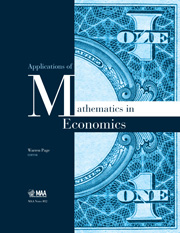Book contents
- Frontmatter
- Contents
- Preface
- Notes on the Sections
- Problems and Subject Areas
- 1 Microeconomics
- 2 Scenarios Involving Marginal Analysis
- 3 Intermediate Macroeconomics Theory
- 4 Closed Linear Systems
- 5 Mathematics in Behavioral Economics
- 6 Econometrics
- 7 The Portfolio Problem
- 8 Topics in Modern Finance
- 9 Maximizing Profit with Production Constraints
- About the Editor
- About the Authors
2 - Scenarios Involving Marginal Analysis
- Frontmatter
- Contents
- Preface
- Notes on the Sections
- Problems and Subject Areas
- 1 Microeconomics
- 2 Scenarios Involving Marginal Analysis
- 3 Intermediate Macroeconomics Theory
- 4 Closed Linear Systems
- 5 Mathematics in Behavioral Economics
- 6 Econometrics
- 7 The Portfolio Problem
- 8 Topics in Modern Finance
- 9 Maximizing Profit with Production Constraints
- About the Editor
- About the Authors
Summary
Introduction
Many economic decisions involve investigating the effects of small changes on various outcomes. Analyzing the effects of small or incremental changes allows us to investigate factors affecting cost, revenue, and profit in microeconomics. Economists use the term “marginal” to connote the change due to a one unit change in something. For example, to an economist, marginal cost (MC) means the change in total cost from producing one more unit of q, and marginal revenue (MR) is the change in total revenue from selling one more unit of q. Since the rate of change at a value is represented by the derivative, the word “marginal” in economics is approximated by the derivative. Thus, MC = d(TC)/dq. Knowing how a function changes can also be useful in economics situations where it may be difficult to obtain exact data, but where approximations will suffice for decision-making.
Fixed costs (e.g., lease payments on a rented building, fixed monthly fee for the business answer phone, installment payments for purchased equipment) are incurred regardless of whether any output is generated, and do not depend on the amount of output the firm produces. Variable costs vary with the output level of the firm. A cost function is derived from observation of the relationship between costs and level of output. A principal goal of the economist/mathematician is to model the costs of operation as closely as possible to what actually occurs in the production process and to tie the costs of production to the level of output being produced.
- Type
- Chapter
- Information
- Applications of Mathematics in Economics , pp. 17 - 26Publisher: Mathematical Association of AmericaPrint publication year: 2013

